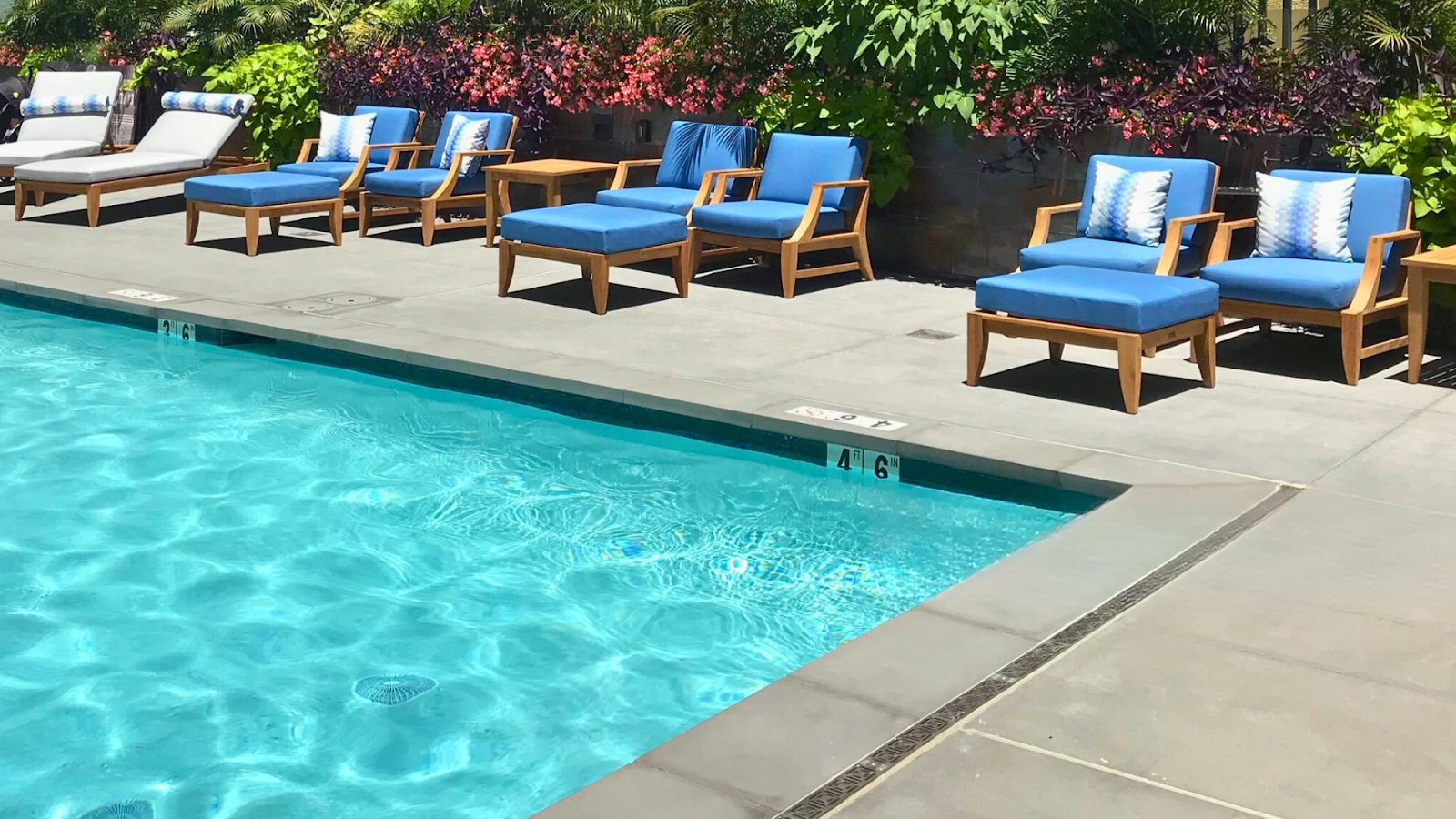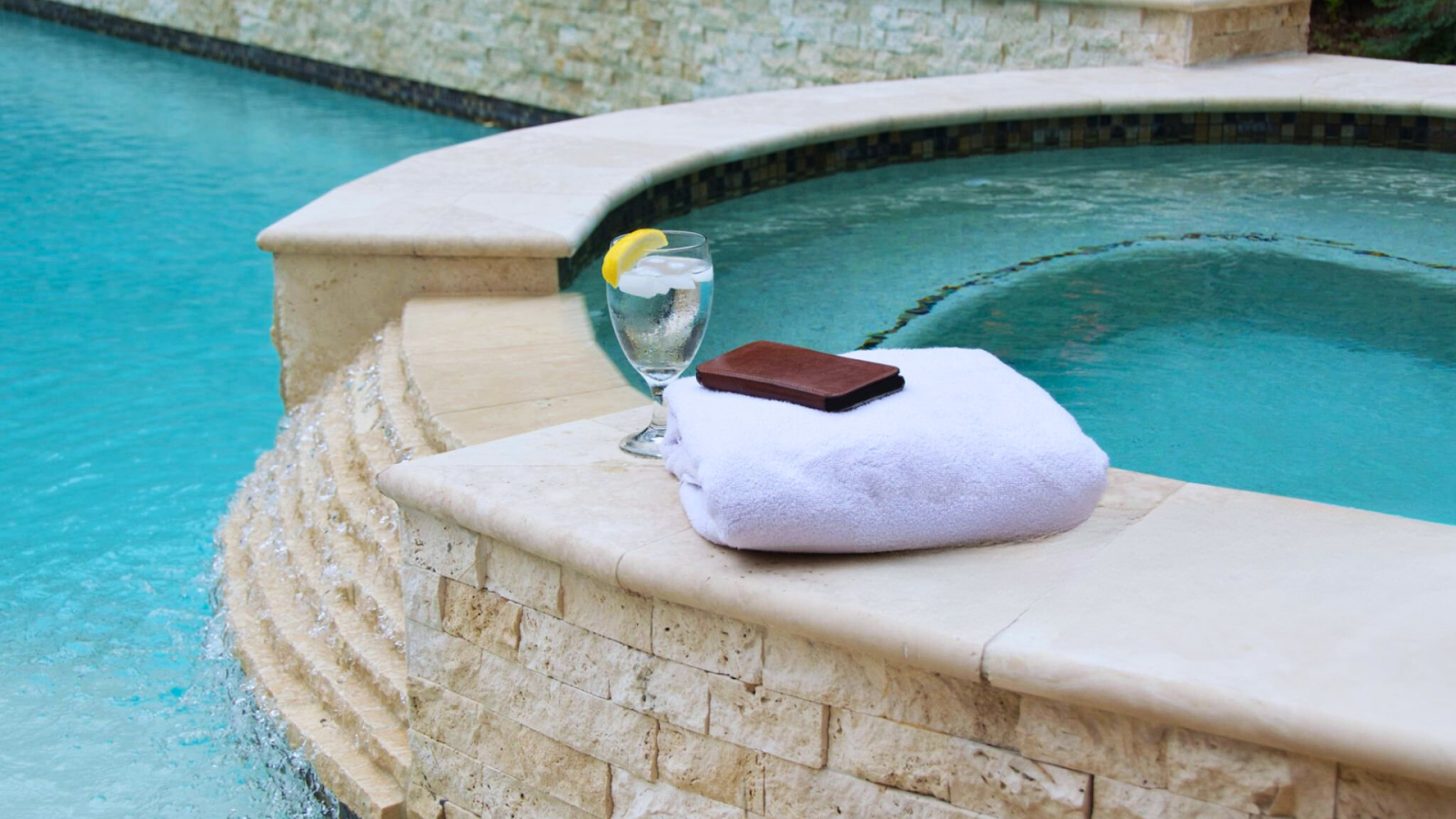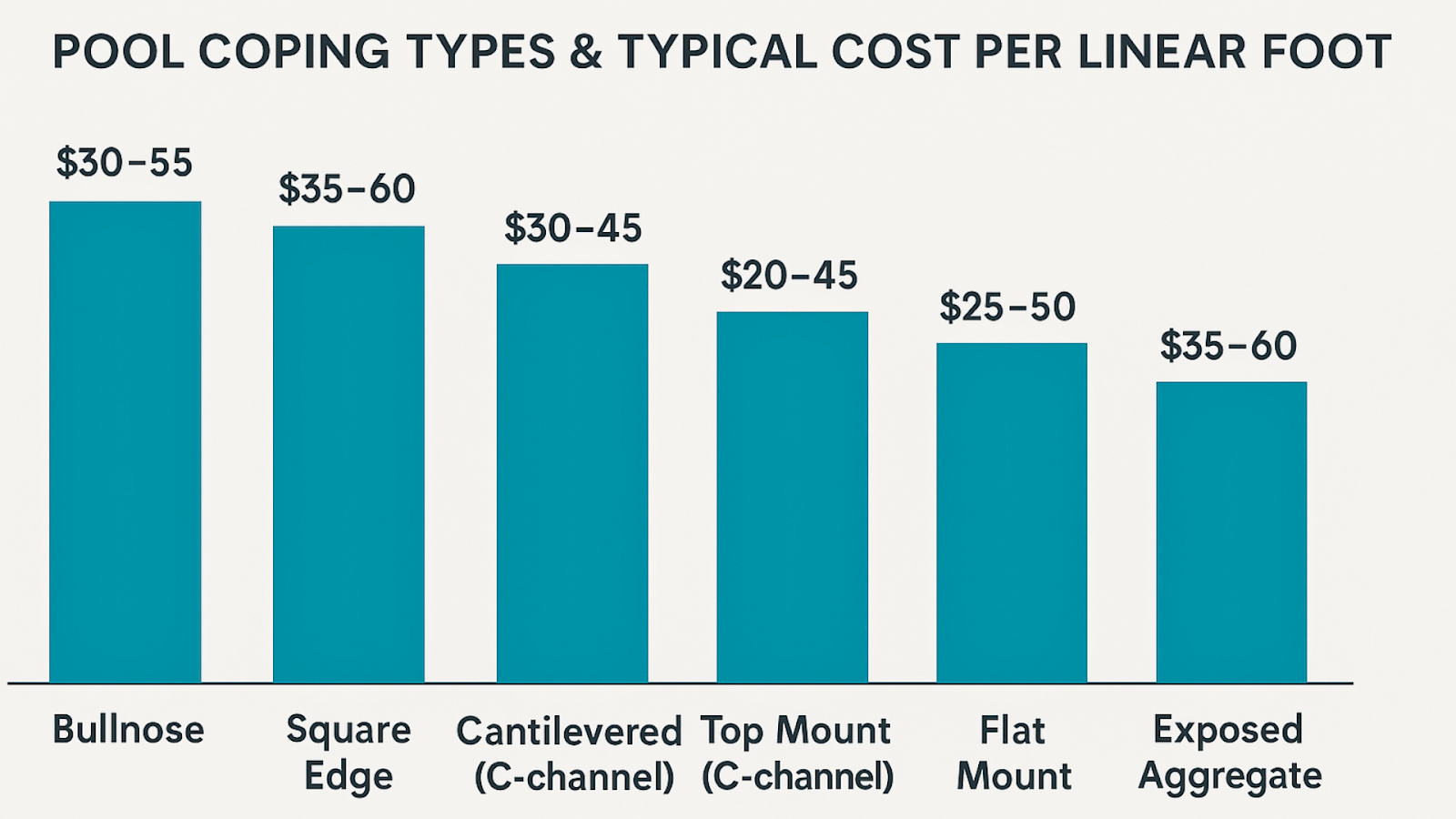What Is Pool Coping? Why It Matters & How To Choose The Right One? [2025]


One of the things that many often overlook when planning a pool is the pool coping. You might think it’s a small part of the pool and you could leave it to your pool builder to decide, but that is probably not a good idea if the people you are dealing with are not experienced enough.
Speaking from my years of experience, I can tell you that every detail of a pool is important, even as small a part as the pool coping. It can directly change the pool’s overall look, safety of swimmers, and longevity.
Whether it’s a smooth bullnose edge you grip climbing out, or a crisp modern square edge finishing off a luxury rooftop pool, coping acts as a decorative aspect, plus more.
They help to keep water where it belongs, protect your pool structure, and create the visual frame that ties your entire design together.
Today, I’ve decided to put together a quick guide to help homeowners like you have some additional knowledge on pool coping (such as choosing the right style, material to match your design and climate, budget, etc.) so that you can decide if your pool builder is suggesting the right one or not.
It’s quite simple, but after reading, you will understand what they are and hopefully, realize that my pool building experience is not like ordinary, new pool builders, leading to trusting my advice.
So let’s begin.
TL;DR – What Is Pool Coping - Material, Type, And More
- Pool coping is the protective and decorative cap that finishes the top edge of an in-ground pool.
- It keeps water and debris out of the pool shell, hides concrete edges, and creates a safer, more comfortable edge to sit, stand, or hold onto.
- Materials range from concrete and brick to travertine, marble, and sandstone — each with pros, cons, and cost differences.
- Styles include bullnose, square edge, cantilevered concrete, and more, shaping your pool’s aesthetic from classic to contemporary.
- Choosing the right coping means balancing durability, slip resistance, heat retention, style, and budget.
- Talk to experienced pool builders (such as Hammerhead Pools) early. Retrofitting coping after concrete is poured can be complex and costly.
Now let’s get into the details.
So, What Exactly Is Pool Coping?
Pool coping acts as a protective cap that sits on the edge of the pool or the bond beam, i.e., the concrete and steel structure at the top edge of your pool shell.
- Think of it as a seal that keeps splash-out water and rain from seeping behind the pool shell.
- It maintains safety and comfort for swimmers when grabbing the edge.
- And it’s a visual “frame” that ties your deck and pool together.
So, a proper coping will direct water away into the deck drains, cover the raw concrete edges & steel, and often add color, texture & architectural style to your swimming pool.
As you can tell, though it’s a small detail of your pool, it does play a huge role every time someone walks, sits, or climbs in and out of your pool.
Key Materials For Pool Coping - Pros, Cons & Cost Considerations
There are several materials that can be used for pool coping. And they each have their own pros and cons in terms of look, comfort, and maintenance needs.
The following are materials I have used in several pool projects.
1. Concrete Pool Coping

Concrete remains one of the most popular choices for pool coping because it’s incredibly versatile and budget-friendly.
It can be poured on-site to create smooth, seamless edges, or precast into custom shapes and profiles like bullnose or square edge.
- Concrete blends well with both modern and traditional pool designs.
- It can be stamped or stained for different textures and colors.
- Concrete tends to be easier on the wallet compared to natural stone.
It will give you and pool builders high flexibility for design without costing a fortune, making it the most commonly chosen material for pool coping.
2. Pavers

Pavers are a special mix of modular pieces made from concrete, stone, or porcelain that come in a huge variety of colors, textures, and finishes.
When using pavers, the biggest advantage you will get is that if a single paver chips or cracks, you can easily remove and replace it without disturbing the entire pool edge. (Of course, early on, don’t try it yourself without professional help.)
Plus, if you want curved pool windows/edges or custom patterns, it's a lot easier to set the coping using pavers.
They blend well with matching pool decks or walkways and are often chosen just for the visual elegance they can provide.
Overall, their mix-and-match nature, high durability, and easy repairing capability make them a popular choice among many homeowners.
3. Pool Coping Using Travertine

If you would rather have a natural look, then you may consider using travertine. It’s a prized natural stone, well-demanded for its elegance and comfortable, cool-to-the-touch surface (even under the strong summer sun).
I personally love working with travertine. Its naturally slip-resistant surface due to its textured finish just feels amazing. You could be in Dubai on a rooftop pool, and still not feel the unbearable heat when chilling on the pool edge or walking by it.
It’s the best coping material if you are building a pool in warmer climates.
You will find several tones of travertine, soft beiges, and cream tones, giving your pool coping a Mediterranean or tropical look.
It will deliver both comfort and a luxurious outlook to your swimming pool.
4. Marble Coping

While travertine or pavers seem like great choices, they often do not match the surroundings too well for high-end pools. They are more of great choices for private luxury pools for people who love nature and vibrance.
But for most high-end luxury pools, often for commercial use, marble would be your choice for pool coping.
Marble has this unique, luxurious feel, smooth, glossy finish, and striking natural veining.
Visually, it adds instant sophistication and a polished, upscale look. In a contemporary or resort-style pool, marble simply makes the swimming pool stand out.
However, from my experience, I will tell you that marble tends to absorb and retain heat, making it warmer underfoot in direct sun. And due to high demand, they usually cost more.
I do not recommend using marble in rooftop pools, and for high-end clients with limited budgets, I often suggest an alternative besides marble so that they do not feel like I’m ripping them off.
Still, if you think you want the highest level of elegance, then marble is worth the investment, as it will make your pool into a masterpiece.
5. Brick Coping

In case you want a backyard pool or a vintage design, then brick coping is great to offer a timeless, traditional appearance that matches perfectly with the surroundings.
On top of that, brick coping tends to be highly durable, resists wear over time, and requires little day-to-day maintenance.
You will get the option to set up brick coping in several earthy tones, adding warmth and a familiar charm to any setting.
However, the downside of brick coping is that if it cracks or chips, it’s difficult to replace a single unit compared to pavers. Plus, it is not always suitable for the pool. But, they do not usually chip/crack for a few years.
Whether you should use it or not will depend largely on the location of your pool and the outlook of the surroundings, as they do not really blend in with most modern designs.
7. Sandstone & Limestone

These are a bit less popular. Sandstone and limestone can form unique color variations, rich textures, and a natural, rustic feel to pool coping. They blend beautifully with natural surroundings, especially in gardens or desert-inspired designs.
However, they require regular sealing to protect them from staining and moisture absorption (as these stones are naturally porous). So, if you want an organic look and don’t mind occasional maintenance, then you can use such coping to create a warm, inviting edge around the pool.
P.S. I have rarely suggested Sandstone & Limestone pool coping to my clients. Maybe I have offered it to only a couple of clients many years back. But I feel they are not way out of trend and are rarely demanded.
8. Flagstone & Bluestone

Flagstone and bluestone are amazing materials for sophisticated pool coping. I personally love pools that have such coping, as they make swimming pools look more luxurious.
They usually stand out for their irregular shapes and rich natural hues (ranging from cool blues and greys to earthy browns and tans).
If you want a truly custom, handcrafted look that feels organic yet modern, then this would be a great choice. Plus, they usually blend naturally with the landscaping or stone patios.
However, these tend to have very low heat resistance and tend to get much hotter compared to other materials. So I recommend you do not use them in areas where the climate can get very warm.
So it’s a material that offers natural beauty and texture, but absorbs heat like crazy, meaning if you should use them will depend on your location’s climate.
They deliver a truly custom, handcrafted look that feels organic and blends seamlessly with landscaping or stone patios. These stones do tend to absorb and hold heat, so they’re best used in climates where poolside areas won’t get uncomfortably hot, or where swimmers use sandals or pool shoes. Their natural beauty and texture, however, often outweigh this drawback.
Pro Tip: When discussing with your pool builder, don’t choose by price alone. Consider how hot the coping gets in summer sun, slip resistance for kids, and how it fits your pool’s style.
Pool Coping Styles And How They Shape Your Pool’s Look

The profile of your pool coping, i.e., the shape and edge style, might seem like a small design choice, but it powerfully influences both the visual character of your pool and how it feels to use day-to-day.
The following are the most effective pool coping styles:
1. Bullnose
The bullnose profile features a gracefully rounded front edge. It’s timeless, practical, and one of the most popular choices because it feels smooth and comfortable under hand and foot. This softer curve is especially family-friendly, making it easier (and safer) to grip when climbing in or out of the pool.
2. Square Edge
With its clean, sharp lines, a square edge profile brings a distinctly modern and architectural feel. It creates a crisp border that complements contemporary designs and minimalist outdoor spaces. While it looks striking, keep in mind that it feels firmer to the touch compared to a rounded edge.
3. Cantilevered Concrete
This style involves pouring the pool deck so it slightly extends over the pool wall, creating a seamless overhang. The result is a smooth, integrated finish that visually connects the deck to the water. It’s perfect for modern pools where you want the coping to look almost invisible, blending the deck and pool together.
4. Top Mount (C-channel)
Most often found in vinyl liner pools, this practical profile uses an aluminum or metal track that supports the liner while also acting as coping. It’s designed for function first, providing both structure and a neat finish at the waterline.
5. Flat Mount
Flat mount coping also uses a track to secure the liner, but instead of acting as the finished edge, it serves as a base where you can install separate coping stones or pavers. This gives you design flexibility to add natural stone or custom finishes on top.
6. Exposed Aggregate
This finish uses concrete where the outer layer is removed to reveal natural pebbles, stones, or glass. It adds texture and slip resistance while creating a decorative, earthy look that feels unique around the pool’s perimeter.
Why Profile Choice Matters
Choosing your coping style isn’t just about appearance:
- Rounded profiles (like bullnose) are generally safer and more comfortable for families and everyday use.
- Sharper, square profiles emphasize a modern design aesthetic but can feel harder underfoot and at the edge.
Ultimately, the coping profile frames the pool visually, affects comfort and safety, and helps tie together the entire look of your outdoor space.
Cost & Comparison Of All Pool Coping Styles

(You will get the answer to “How much does Pool Coping Cost?” and get a direct comparison of each pool coping style.)
Costs vary by material, design, and location, but here’s a rough guide, Pool Coping Styles: Materials, Pros, Cons, and Typical Costs
• Bullnose Coping
- Possible Materials: Concrete, brick, travertine, marble, pavers
- Pros: Smooth, rounded edge; comfortable and classic look; safer grip for kids
- Cons: Slightly traditional feel, less modern than sharp edges
- Typical Cost (per linear foot): $30–$55
• Square Edge Coping
- Possible Materials: Concrete, travertine, marble, limestone, pavers
- Pros: Modern, crisp lines; matches contemporary architecture
- Cons: Harder edge, may feel less comfortable than rounded options
- Typical Cost (per linear foot): $35–$60
• Cantilevered Coping
- Possible Materials: Poured concrete (can be textured, stained, or stamped)
- Pros: Seamless, minimalist look; can integrate with deck
- Cons: Limited to concrete; harder to repair or replace
- Typical Cost (per linear foot): $30–$45
• Top Mount (C-channel) Coping
- Possible Materials: Powder-coated aluminum track with pavers or stones
- Pros: Supports vinyl liners; affordable and practical
- Cons: Only fits certain pool types; visible metal edge
- Typical Cost (per linear foot): $20–$40
• Flat Mount Coping
- Possible Materials: Track plus stone, pavers, or concrete on top
- Pros: Holds liner securely; wide material choice
- Cons: More complex installation; track may be visible
- Typical Cost (per linear foot): $25–$50
• Exposed Aggregate Coping
- Possible Materials: Custom concrete mix with natural pebbles and stones
- Pros: Highly slip-resistant; unique, textured look
- Cons: Rougher underfoot; harder to clean than smoother styles
- Typical Cost (per linear foot): $35–$60
Natural stones are often the most expensive, but they can really enhance your pool’s look and increase property value.
Are There Alternatives To Traditional Coping?

Yes. Some modern pools skip separate coping by extending the deck material slightly over the pool’s edge (called cantilevered decking).
It creates a minimalist, seamless look — popular in contemporary designs.
But remember:
- You’ll still need a structural bond beam and careful waterproofing.
- It may limit your choice of deck materials.
How to Choose the Right Coping: Key Factors
From years of pool building experience, here’s what should matter:
- Durability: Will it last decades without chipping or cracking?
- Slip resistance: Especially if kids or seniors will use the pool.
- Heat retention: Natural stones like travertine stay cooler than marble.
- Style & texture: Rounded bullnose or sleek square? Smooth or lightly textured?
- Maintenance: Some materials need sealing; some are nearly maintenance-free.
- Budget: Balance upfront cost with long-term durability.
Pro tip: Before making a decision, ask the pool builder to provide real samples. Then view them in sunlight and wet them — colors and texture look different when wet.
Final Thoughts: Small Detail, Big Impact
Pool coping is a technical necessity, and plays a big part in safety, style, and everyday comfort of your swimming pool.
From classic bullnose brick to ultra-modern poured concrete, the right coping can transform your pool from “nice” to “extraordinary.”
And planning matters: it’s far easier (and cheaper) to design coping before construction starts than to rebuild later.
Get Expert Advice
If you’re still deciding on materials, style, or cost, or want to see what fits your climate and pool shape best, talk to a team that’s done it before.
With Hammerhead Pools, I’ve spent over two decades helping homeowners and resorts build high-end swimming pools, and the company has a proven track record. The least you can do is request a free analysis and estimate before you decide. You may reach out here.
FAQs About Pool Coping
1. Is pool coping necessary?
Yes — it protects the pool shell, directs water, and adds a safe, comfortable edge.
2. What coping is coolest underfoot?
Travertine and light-colored pavers tend to stay cooler than marble or darker stones.
3. Can coping be replaced without redoing the whole pool?
Often yes, especially if built with modular pavers; poured concrete is harder to repair.
4. Do saltwater pools need special coping?
Natural stones like limestone can be more prone to erosion; sealing helps.
5. What’s the most popular coping style?
Bullnose remains timeless, but square edge and cantilevered concrete are trending in modern designs.
Pool coping is more than a finishing touch—it's vital for safety, comfort, and lasting style. With the right choice of material and edge profile, you can enhance your pool’s function and appearance for years to come. Always consult experienced professionals to find the best solution for your needs.











